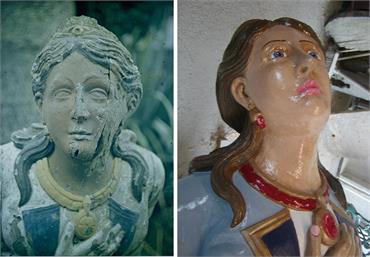July 31 2013.

Having spent the winter in Sheffield and Dartmouth getting a makeover, one of Seaford Museum's painted ladies is expected to return this Friday, the 2nd of August, to eventually take pride of place on display in the Museum. "She may be a painted lady who's seen a bit of the world in her time, but we love her!" commented David Swaysland from Seaford Museum, on the news that "Phoebe", the second of the Museum's ships figureheads is coming back to Seaford in time for the summer.
In December 2012, Phoebe was hoisted out of the depths of the Museum's extensive underground exhibition area to be taken off to the workshops of Richard Hunter in Sheffield, the UK's leading figurehead restorer. (www.figureheads.co.uk ). She has been expertly cleaned, some areas have been re-carved and she's been re-painted by Richard, based on the few flecks of paint which remained embedded in the grain of her wood, and his expert knowledge.
Sadly the Museum is still largely ignorant of her history before the 1960s, when she was rescued from Seaford Urban District Council's Destructor site in Brooklyn Road by Mrs Doris Pilkington and her daughter, to spend many years at Litlington Tea Gardens, before being moved to Seaford Museum in1974. Even her adopted name of "Phoebe" was given her by the Pilkington family, as she had no other known name.
Rumour has it that she was, for a time, in the garden of a house on Seaford seafront and moved to Council care around the time of the 1939-45 war, along with the Museum's more famous figurehead which came from "The Peruvian". However, very extensive research by local author Diana Crook, who has helped to finance Phoebe's restoration, has not produced any leads as to her identity.
"Her size, she stands 7 feet tall, suggests she came from a large 'distant shores' vessel, perhaps a three masted barque, and Richard Hunter believes she is of British, rather than Scandinavian, European or American origins, but that has to remain speculation. Unfortunately there have been so many shipwrecks along our coast, and there was a thriving Victorian trade in redundant ship's figureheads as garden curiosities, that she remains an enigma" says Diana Crook.
Phoebe can be viewed by visitors to Seaford Museum at the Martello Tower on Seaford seafront, along with "The Peruvian" figurehead and all the other exhibits at the Museum.
"Of course if anyone is able to shed any further light on our painted lady's past, we'd be delighted to hear from them" added Diana.
Pictured above: Phoebe before and after her makeover.